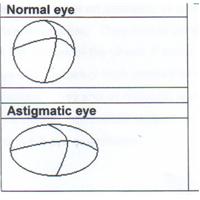
Astigmatism is one of the most common eye conditions – most people have it to degree. It is often mistakenly referred to as ‘stigmatism’.
Astigmatism occurs when the cornea or lens are shaped more like a rugby ball – more curved in one direction than the other. And light is not focused on one point on the back of the eye. For instance, vertical lines may be clearer than two horizontal or vice versa.
This means that the image at the back of your eye is not as sharply focused and vision may be blurred. Corneal astigmatism is when the cornea is a distorted shape and lenticular astigmatism occurs when the lens is distorted.
To focus images, the eye has two parts – the cornea and the lens. The cornea is the curved ‘window’ at the front of the eye. When the cornea and the lens inside the eye area are a regular symmetrical shape all incoming light is sent the same way to make a sharply focused image onto one single point on the retina at the back of the eye. The retina is the light-sensitive area at the back of the eye, like the film in a camera. If light is only focused on one part of the eye, vision will be clear.
Most people with astigmatism are born with the condition, although it can develop throughout life. A condition called keratoconus can also change the shape of the cornea with age and this can cause astigmatism. Rarely, astigmatism can be as a result of an injury or eye disease. Usually a person with astigmatism will have other visual problems, such as long or short sightedness.
Those people with a small degree of astigmatism may not experience any problems. Those whose astigmatism is more significant may experience any or all of the following:
* Blurring and distortion of near or far-away objects
* Headaches when trying to focus
* Senstivity to light
* Tired and dry eyes
In some cases, astigmatism is present at birth as the size and shape of the eye is developed in the womb. It may be due to environmental and genetic factors, but the exact cause is not always known. Sometimes an astigmatism can develop after an eye injury, surgery or eye disease. Astigmatism is not caused by factors such as reading in poor light, squinting or watching too much television.
Although astigmatism is extremely common and afffects most people to some degree, many may not need any corrective action. Most people who wear glasses or contact lenses may have some degree of astigmatism. Treatments include corrective spectacle lenses, special contact lenses or surgery.
People with astigmatism cannot see horizontal or vertical lines clearly at the same time. This is what makes objects appear blurry or out of focus.
For those who have astigmatism, an optometrist, ophthalmic surgeon or eye specialist should carry out a full eye examination to assess the full scale of the problem. Options for correction can be discussed in full. Corrective glasses, special contact lenses or surgery are all options. A regular eye test is vital to maintaining healthy eyes. We should each aim to have our eyes tested every two years at least.
